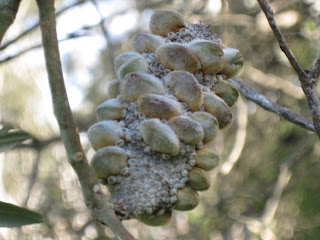




Australia's 78 species of banksia give vibrancy and rugged texture to our vegetation. Named after Sir Joseph Banks (the 'father' of Australian botany), banksias were first observed by him in 1770, at Botany Bay.
Sometimes described as bottle brushes, honeysuckles or candlesticks, the flowers and cones are highly sought after for floral arrangements -- worldwide.
Each large showy flower is actually a dense cluster of up to several thousand individual blooms. The flower spike develops into a woody cone -- after flowering -- with each of the tightly closed woody capsules containing one or two winged seeds. The seeds are usually released after a bushfire.
Coastal banksias (Banksia integrifolia) grow to about 25 m, have narrow leaves that are silver underneath, and have pale yellow flower spikes. They are popular with nectar-loving birds and seed-eating parrots.
Old trees develop stunning gnarled trunks with rough speckled bark, often adorned with orange lichens. They make a dramatic statement in coastal vegetation on Phillip Island.
PS
Tomorrow I'll show you some of the uses made of banksia flowers and cones, and also how they've been used in children's literature.
No comments:
Post a Comment